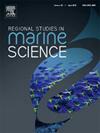牡蛎的蓝碳潜力:全球牡蛎产量和年增长率综述
IF 2.1
4区 环境科学与生态学
Q3 ECOLOGY
引用次数: 0
摘要
由于牡蛎具有通过钙化储存碳的能力,因此被认为是蓝碳的重要候选者。本研究旨在比较主要养殖牡蛎物种的生长情况,以有效固碳,并确定气候变化对牡蛎生长的影响。结果表明,悬浮培养的长角藻和大麦哲藻的固碳潜力效率(CSE)最高,分别为2.98和2.89,底培养的毛竹牡蛎最低,为1.03。牡蛎生长的最佳海表温度(SST)为24 ~ 28 ℃,最佳盐度为25psu左右。在气候变化导致海温升高1 ℃的情况下,比较过去和现在的M. gigas生长没有显著差异。然而,由于气候变化引起的疾病增加,死亡率急剧上升。本研究支持全球牡蛎管理和保护工作,同时有助于收集必要的生物数据。本文章由计算机程序翻译,如有差异,请以英文原文为准。
Blue carbon potential of oyster: Review of global oyster production and annual growth rate
Oysters have been considered as an important candidate for blue carbon due to their ability to store carbon through calcification. This study aims to compare the growth of major cultured oyster species for effective carbon sequestration and determine the impact of climate change on oyster growth. The results showed that suspended cultured Crassostrea angulata and Magallana gigas had high carbon sequestration potential efficiencies (CSE) of 2.98 and 2.89, while bottom cultured Ostrea edulis had the lowest CSE of 1.03. Oysters' optimal growth sea surface temperature (SST) was 24–28 ℃, and the optimal salinity was around 25psu. Comparing past and present M. gigas growth with a 1 ℃ increase in SST due to climate change did not show significant differences. However, mortality increased dramatically due to the rise in diseases caused by climate change. This study supports global oyster management and conservation efforts while contributing to essential biological data collection.
求助全文
通过发布文献求助,成功后即可免费获取论文全文。
去求助
来源期刊

Regional Studies in Marine Science
Agricultural and Biological Sciences-Ecology, Evolution, Behavior and Systematics
CiteScore
3.90
自引率
4.80%
发文量
336
审稿时长
69 days
期刊介绍:
REGIONAL STUDIES IN MARINE SCIENCE will publish scientifically sound papers on regional aspects of maritime and marine resources in estuaries, coastal zones, continental shelf, the seas and oceans.
 求助内容:
求助内容: 应助结果提醒方式:
应助结果提醒方式:


